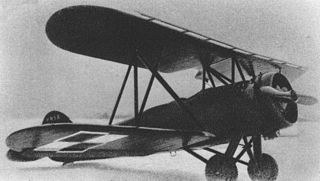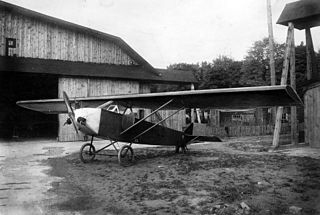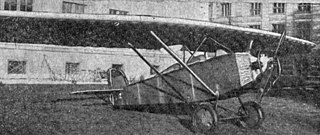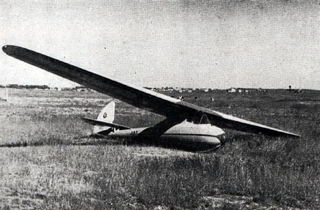Related Research Articles

The Nikol A-2 was a small, amphibious aircraft designed and built in Poland in the 1930s. Only one was completed before World War II.

The PWS-20 was a Polish single-engine high-wing 8 passenger airliner, built in the PWS factory and when it made its first flight in 1929 it became the first Polish-designed transport aircraft to fly.
The Parnall Parasol was an experimental parasol winged aircraft design to measure the aerodynamic forces on wings in flight. Two were built and flown in the early 1930s in the UK.

The PWS-6, was a Polish liaison aircraft, developed in 1930 by the PWS, that remained a prototype.

The Schmeidler SN.2 was a low power, single seat aircraft designed in Germany in the 1930s to test the ability of trailing edge wing extensions to lower minimum flight speeds without a high speed drag penalty.

The Lachassagne AL 5 was a French low power, single seat sports aircraft with novel, in-flight variable camber wings and tailplane. It first flew in 1930; at least two were built.

The parasol wing, single engine Udet U 8, sometimes referred to as the Limousine, was a three-seat commercial passenger transport designed and built in Germany in 1924. Five were produced and were used by German airlines until about 1928.

The Medwecki HL 2 was a Polish two seat lightplane flown in 1927. Handicapped by a low power, unreliable engine, its flying life lasted little more than a month.
The Medwecki and Nowakowski M.N.3 or just M.N.3 was a low-powered, four seat, Polish aircraft flown in 1928. The sole example was modified into a more powerful two-seater which served aeroclubs until World War II.

The Medwecki and Nowakowski M.N.5 was an economical Polish trainer aircraft initially aimed at the club market, though there was also some military interest. It performed well but lacked a constructor after Samolot became insolvent in 1930, so only one was completed.

The Rogalski and Wigura R.W.1 was designed and built by a pair of students at Warsaw Technical University in 1927. The single example was a two-seat parasol-wing monoplane which entered two national competitions, served the Warsaw Academic Aeroclub and also towed an advertising banner.

The Gabriel P 5 was the first nationally developed aircraft to fly in Poland after it became independent in 1918. It was an amateur-built, low-powered, single seat parasol wing machine. Only one was completed.
The Gabriel P 6 was a Polish training aircraft and the P 7 a tourer. The difference between them was the wing configuration, chosen to optimise their speed range for their role, so the P 6 was a biplane and the P 7 a parasol wing aircraft.
The Silesia S-4 was a Polish, low-power parasol wing aircraft built in 1925. After an engine change and airframe modifications it became one of the Silesian Aeroclubs fleet. It was lost in a take-off accident in 1931 and was the last Silesia aircraft to fly.
The D.K.D.3 was a Polish, single seat, parasol-wing sports aircraft first flown in 1927. Only one was built but flew in demonstrations and in national competitions into the early 1930s.
The LKL IV and LKL V were a pair of very similar Polish parasol wing two-seaters, built in the early 1930s. They differed primarily in their engines.

The Sido S.1 was a Polish two seat, parasol wing trainer aircraft, first flown in 1930.
The MIP Smyk, MIP from the initials of its Polish designers with Smyk meaning Brat or Kid, was an aerodynamically refined motor glider designed and built at Warsaw Technical University from 1935.

The Tarczyński and Stępniewki TS-1/34 Promyk was a Polish short span, high performance sailplane from the mid-1930s and was the first Polish sailplane equipped with flaps. Its construction was delayed by a financial crisis and its development terminated by World War II.
The PWS-103 was a high performance, Polish 15 m span sailplane developed from the longer-span PWS-102 just before World War II.
References
- ↑ Anderson, John D. Jnr. (1997). A History of Aerodynamics. Cambridge: Cambridge University House. pp. 268–82. ISBN 0-521-66955-3.
- 1 2 3 4 5 6 7 Cynk, Jerzy (1971). Polish Aircraft 1893-1939 . London: Putnam Publishing. p. 588-590. ISBN 0 370 00085 4.
- ↑ Cynk (1971) pp.672-3